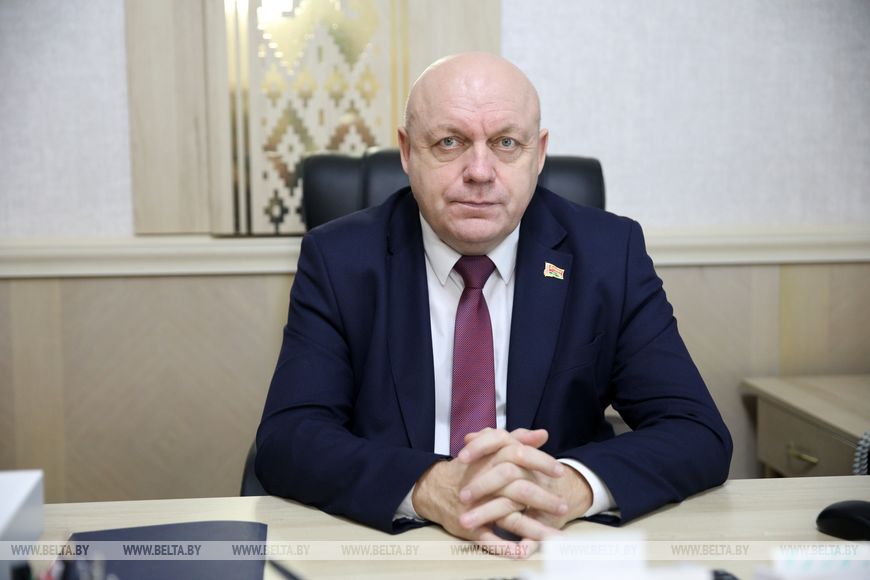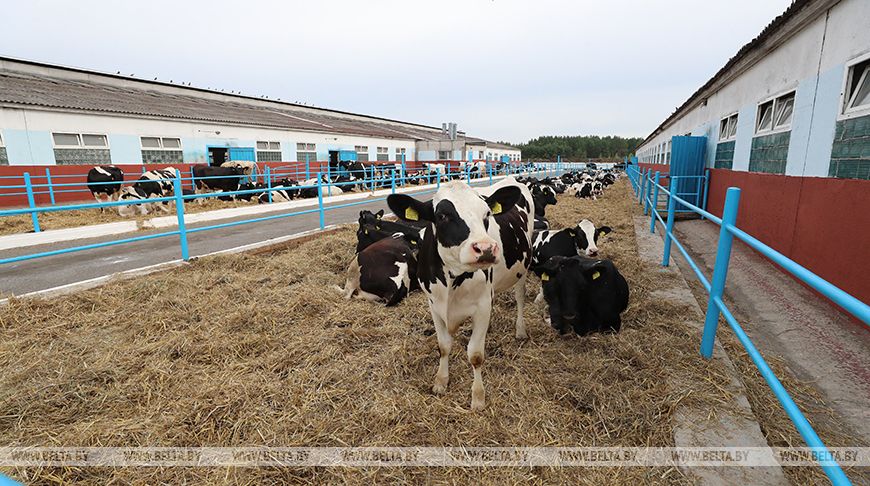Sysoev on the development of agriculture in the Minsk region: records are the result of progressive movement forward

This year, the agricultural sector of Minsk Oblast has broken records in many respects: the region’s farmers have received an unprecedented grain harvest, including corn, and have secured a year and a half’s supply of grass feed. Livestock farming is developing intensively, which is facilitated, among other things, by the commissioning of new facilities. And what is no less important is that rural workers in the central region receive a good return on their efforts in the form of high salaries. On the eve of Agricultural and Processing Industry Workers’ Day, First Deputy Chairman of the Minsk Oblast Executive Committee Vasily Sysoyev told a BELTA correspondent about what contributes to the progressive development of all areas of agricultural production, plans for the future, and those who will ensure progress.
— Vasily Vasilyevich, today we can essentially sum up the results of the agricultural year, since the completion of the corn harvest has been officially announced in Minsk Oblast. How much does a loaf of bread in the central region weigh and are you satisfied with the result?
— The corn harvest in the Minsk region was completed within the timeframe set by the head of state — by November 7. The weight of our final loaf is 2 million 874 400 thousand tons, of which almost 785 thousand tons is corn grain. I would like to note that in the total loaf of the republic we occupy 28%, and as for corn, we provide exactly a third of its reserves in the country.

The harvest in 2024 was unprecedented, both in terms of grain and in terms of total threshing. This has never happened in the Minsk region: the highest result of 2.4 million tons was achieved in 2022. Our task is to reach 3 million tons of grain, literally one step remains to achieve it, and we are working hard on it.
— Such a breakthrough in grain production was achieved thanks to the high corn yield. But you must admit that previously, farms could only dream of harvesting the crop for grain.
— All farms in the Minsk region are engaged in growing corn for grain, and work on improving the technology for growing this crop will continue. We are already cooperating with our scientists in this area. Corn in the region occupies almost 300 thousand hectares and can be called the dominant crop, since no other crop has such an area. Of these, about 100 thousand hectares are harvested for grain. In order to improve the silage and grain direction system, we are working with imported and domestic varieties, thinking about sowing dates so that we can have full-fledged corn for harvesting from mid-August. All this is to increase the possibility of its crop rotation. And despite the fact that there are still reserves for increasing corn production volumes, we are satisfied with the result.
—It turns out that in the form of corn grain and silage, the livestock industry received additional volumes of feed units.
—Indeed, thanks in part to a good corn harvest, livestock farming is provided with a year and a half of feed reserves. Moreover, not only silage, but also grain in various forms is laid down. Corn requires serious processing, in particular, drying, and this is a very energy-intensive process, so today we use alternative methods of storing it. For example, we put it in flattened form. For this, about 60 units of flatteners were purchased. We also store it in sleeves and dry and crush it during use. In short, we learn ourselves, we teach workers, because there will undoubtedly be a return.
Harvesting corn for grain should become a priority over harvesting it for silage. This is more profitable both in terms of logistics and in terms of feeding. Increasing the volume of corn production for grain will give us the opportunity to closely engage in haylage, because today alfalfa fields give three or more cuts. By harvesting corn for grain, we can direct the freed up forage harvesting equipment to harvesting alfalfa. And ultimately, we can move away from silage feeding of cattle, leaving in the animal diet a combination of haylage and corn in one form or another. Today, it is also important to determine the varieties of corn in order to move further in this direction.
— Increasing the area of corn, reducing the volume of spring sowing — what else is the secret of the progressive movement of plant growing?
— We are gradually moving away from sowing spring crops, and today winter sowing has reached more than 80% of the total volume. For us, winter sowing has become the number one issue, and we are increasing it from year to year, preparing technically and technologically. Our golden dream is to move away from spring crops in order to sow grain in the fall, and sow corn in the spring. There are already such examples in the regions and they are successfully demonstrated by strong farms. If we completely move away from spring sowing, we will provide ourselves with about 10% of the reserve for increasing the volume of grain crop production. The optimal figure for the region is 400 thousand hectares, and this autumn we sowed 380 thousand hectares. So the task is quite feasible.
—Another strategic crop is rapeseed. Do the region’s farmers get a return on its cultivation?
—The head of state set the task of increasing the volume of rapeseed production for the agricultural sector of the Minsk region. And in order to fulfill it, we will take an extensive path, receiving a return from each hectare of the sown crop, and the optimal areas of 100-110 thousand hectares are allocated for it. We must literally fight for every hectare in terms of compliance with all technological standards.
Rapeseed is a demanding crop and the number of treatments sometimes reaches two dozen, but those areas that are given due attention by the agronomic service pay a hundredfold. We have examples where 50-60 centners were obtained from one hectare per circle. What once seemed unachievable with grain has become achievable with rapeseed.
On average, we plan to get at least 40 c/ha on our fields, and in a couple of years we will double the volume of gross production of rapeseed grain.
This year, the region reached 340 thousand tons, which is also a record figure. Enterprises only benefit from this.
However, other crops also give a return with the right approach. Thus, winter barley, the area of which we are also increasing and bringing their total volume to a quarter, showed good yield.

— Vasily Vasilyevich, Chairman of the Minsk Regional Executive Committee Alexander Turchin has repeatedly emphasized that such results in the industry have their own pattern, this is the result of many years of systematic work. In addition to following the system and technological requirements, what else contributed to the growth of production volumes?
— Building a work system and understanding that we have the largest sowing volumes in the republic, we identified priority types of crops, from which we received a return. In addition, increasing sowing, we had to provide ourselves with equipment. The technical re-equipment of the industry has been going on for many years, and the renewal process is ongoing now. Thus, in 2024, we purchased 150 energy-saturated tractors. This tractor, working 12 months a year, is the heart of the machinery and tractor fleet of any farm, replacing five or six less powerful tractors. They pull the lion’s share of the work. They added wide-grip equipment, without which highly efficient soil cultivation would be impossible. I believe that the global task has been solved, and this year’s results have proven that we are on the right path, which we have been moving towards for at least five years, building up our technical capacity.
The plans for 2025 include the purchase of at least 100 tractors, seeding units, and high-capacity trailers that provide good output. Amkodor is ready to supply us with at least 100 units of such equipment. This will make it possible to clean up the farms and double the volume of organic fertilizer application. Plus, there is a clear understanding of the goals in order to achieve stable work, which will not be hindered by the vagaries of nature or other circumstances.
— Successes in crop production directly affect the volumes of meat and dairy production. How is this area developing, because it is important for people to have meat and high-quality milk with their bread?
— There is a progressive growth process in livestock farming. We would like it to be more intensive, but it is encouraging that even last year’s crop failure due to drought did not affect the rate of livestock production. Today, we are providing a steady growth of 104-105% in milk and will increase the indicators during the winter-stall maintenance period. The output for the year is projected to be slightly less than 7 thousand kg of milk per cow. Milk is the product that brings in the main revenue for our enterprises.
As for poultry and egg production, growth is also ensured here. We are targeting personnel for the same dynamics in the production of cattle meat. To date, a solid feed base has been created: almost 34 feed units per conventional head have been laid down (the highest indicator in the republic). We have no districts where less than 30 feed units have been prepared, and this allows us to say that a one and a half year supply of feed has been created. In the entire history of the Minsk region, such a quantity has never been prepared, so the task is to use it effectively.
— In the Minsk region, many livestock facilities are traditionally built. Last year, for example, 20 MTCs were built with the capital’s support. Is this work continuing?
— In 2023, we commissioned 24 new MTCs, their equipment is currently being completed, and the milk yield for each facility has already exceeded 7 thousand kg per cow.

This year, 25 facilities are in operation, 20 of which will be commissioned. They are being built with government support, including funds from the regional executive committee, for which we are very grateful to the head of the central region, Alexander Turchin, as well as for understanding that without modern facilities we will not be able to ensure the expected indicators in milk production.
There is also a program for 2025, which will include up to 20 facilities. Construction is life, so it will remain intensive over the next three years. Our task is to transfer animals from old premises and completely move away from tethered housing. Also today we are building health centers for calves with the help of the regional budget: 64 such facilities have been built. The plans are for another 60, which we will put into operation in the first quarter of next year.
— The republic is implementing a program for the development of the pig farming industry, according to which new pig complexes will be built. Is Minsk region included in it? I would also like to know about other areas of meat production that are represented in the region.
— We are included in this program and will build a pig complex for 100 thousand heads, for which the Pukhovichi district has been preliminarily identified. It will be built by Borisov KHP, which, among other things, plans to complete the construction of the complexes that are already on its balance sheet at its own expense.
Turkey production complexes in the region have started operating at full capacity: such a facility of the Dzerzhinsky agro-industrial complex has opened in the Kopyl district. Turkey is an export product that is in great demand. Very soon, a quail poultry farm will open in the Soligorsk district, which will contribute to the volume of egg and meat production.
— Farmers make their contribution to the production of agricultural products. How important is it?
— In the total gross production, farm products make up about 1%. However, they have a narrow specialization and some have reached a fairly high level in their area. We are proud of the farmers from the Molodechno district who grow apples and pears. This is where the President of the country was on a working visit this year, highly appreciating the level of the farm. In the same district, there is an enterprise for growing hazelnuts, our farmers from the Smolevichi district work with vegetables, forming the stabilization funds of the region.
— Vasily Vasilyevich, we usually say that personnel decide everything. And in order for them to solve important production problems in agriculture, conditions must be created for workers, including wages. What is the personnel issue in the agricultural sector of the region?
— It is certainly easier for us than other regions to solve the personnel issue, including due to the diversity of enterprises. In addition, the Minsk region has all the soil and climate zones where it is possible to train personnel in all technological processes. We conduct seminars both inter-district and within districts. Everyone has something to strive for, especially since there are many young people who need to be trained.
As for young personnel, we meet with them constantly, summarize interim results, communicate, listen to their problems and help in solving everyday issues. I always advise them to take care of their health, because today it is possible to organize normal nutrition and receive high-quality medical services. I want to note that there are fewer and fewer household issues, since all such problems are solved locally.

I believe that today a young specialist in agriculture has more attractive conditions than in other industries: there are opportunities for personnel growth, the development of one’s own professional potential, creativity (especially in crop production). I am sure that people of action who love what they do can become successful in agriculture and live very decently.
It should also be emphasized that most managers, seeing the efforts of the employee, care about providing housing and the level of wages. There are many examples of this. At the “Dazhynki” in the regions, I have repeatedly noted for myself that there are many young people among those awarded.
We try to work with universities and targeted recruitment. Today, the average wage in agriculture in the Minsk region is the highest in the country and for 9 months is almost Br2 thousand (an increase of 124%). Also, by strengthening the material base of farms, we create decent working conditions: new equipment, modern complexes.
— To summarize the conversation, I would like to outline the main areas of development of the industry in the coming years. What will be the focus?
— As mentioned above, in the next three years we will complete the transfer of the dairy herd to loose housing, for which another 60 new MTCs will be built. During this period of time, we must ensure the output of 8 thousand kg of milk from each cow.
The construction of new fattening facilities from next year will help to reach a new level in the production of cattle meat. The design of such buildings has already begun and the first will appear in the Krupsky district.
As for crop production, we have almost completed the formation of the main areas, only individual aspects will be improved. The region is capable of reaching the figure of 2 million tons of grain excluding corn and rapeseed.
Another important point of development is improving the well-being of our workers, so that they can confidently move forward.
I also want to congratulate all rural workers on the upcoming holiday: without their efforts, professionalism, dedication to the land and their work, such results would not have been achieved.